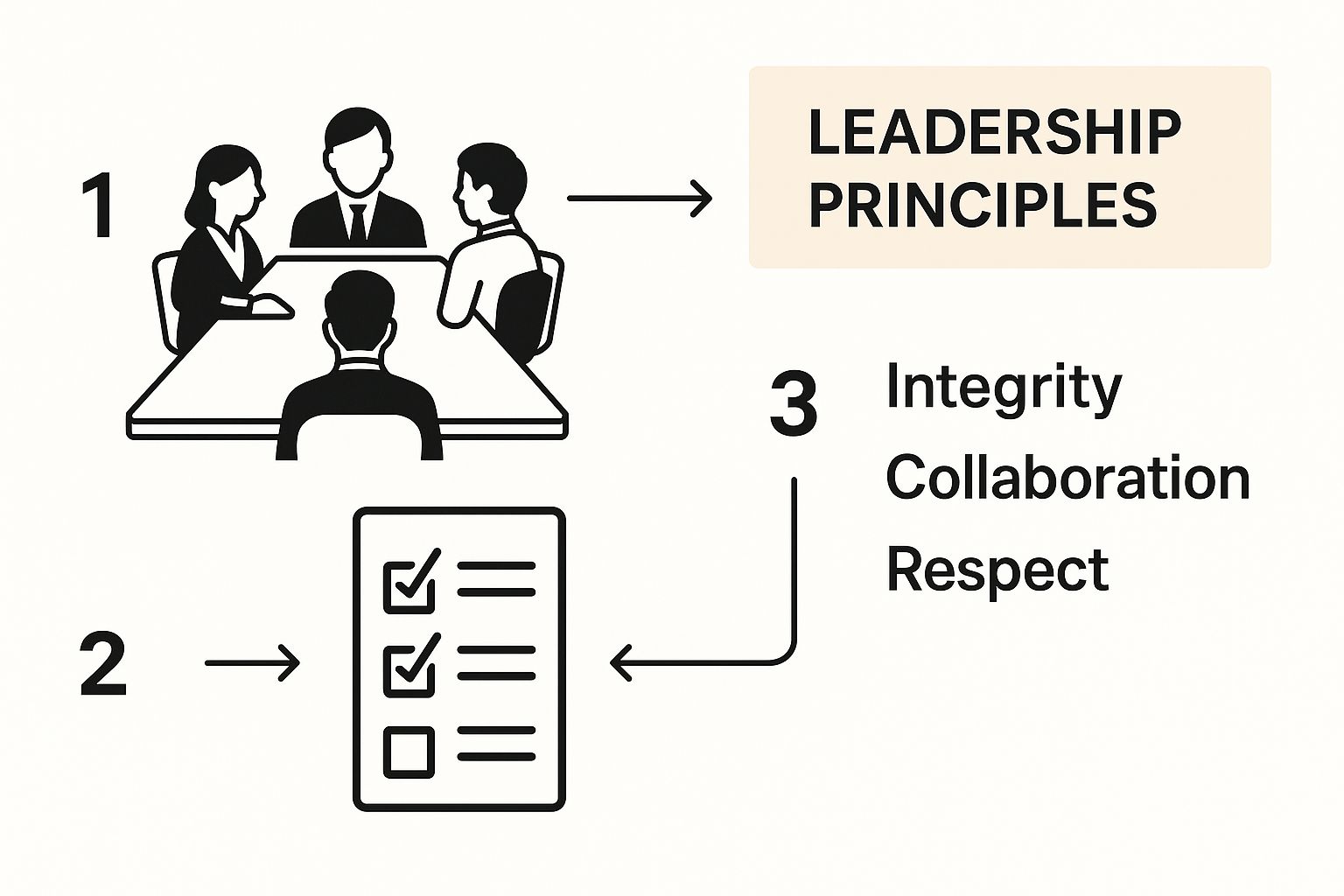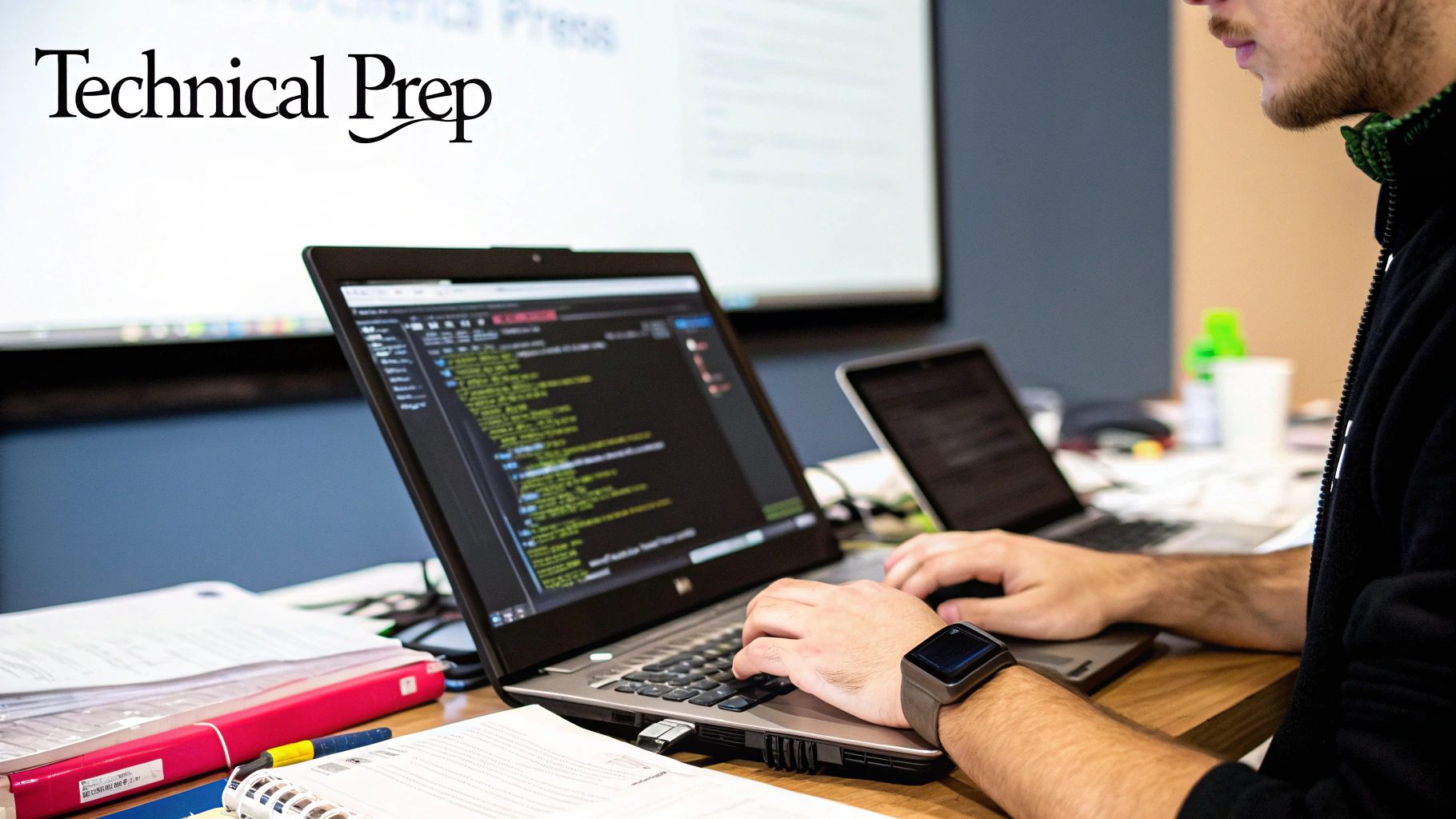A Guide to Mastering Your Amazon Interview Prep

Getting ready for an Amazon interview isn't just about cramming code; it's about a strategic approach that covers your technical chops, your real-world stories, and the company's very specific culture. The secret is breaking down their multi-stage process, knowing their 16 Leadership Principles inside and out, and practicing how you solve problems when the pressure is on.
Decoding the Amazon Interview Gauntlet
First off, congratulations. Just getting an interview at Amazon is a big deal. But from here, the path to an offer can feel like navigating a maze in the dark. To get through it, you need more than just raw technical skill—you need a map.
It's best to think of the Amazon interview process not as one big test, but as a series of checkpoints. Each one is designed to evaluate a different part of your skillset, from your first chat with a recruiter to the intense final "loop."

As you can see, the Leadership Principles aren't just a poster on the wall. They are the framework for everything. Every single interviewer, at every single stage, will be viewing your answers and experiences through the lens of these principles. Your ability to connect your background to these values is what truly separates a decent candidate from an Amazonian.
To help you visualize the journey, here's a quick breakdown of what you can typically expect.
Amazon Interview Stages at a Glance
| Stage | Typical Duration | Primary Focus | Key Tip |
|---|---|---|---|
| Recruiter Screen | 20-30 minutes | Initial fit, motivation, resume review | Have your "Why Amazon?" story ready and be enthusiastic. |
| Online Assessment (OA) | 1-2 hours | Coding proficiency, problem-solving logic | Practice on platforms like LeetCode and understand common data structures. |
| Technical Phone Screen | 45-60 minutes | Live coding, system design, LP stories | Talk through your thought process out loud. The "how" is as important as the "what." |
| The "Loop" (On-site/Virtual) | 4-6 hours | Deep dive on technical skills, LPs, and cross-functional fit | Prepare 2-3 detailed stories for each Leadership Principle. You'll need them. |
This table is a general guide, but it captures the essence of the progression. Now, let's dig into what each phase really feels like.
The Initial Screening Phases
Your journey will almost always start with either an online assessment (OA) or a phone screen with a recruiter. The OA is often a mix of coding challenges and work-style simulations that give them a first look at how you approach problems.
The recruiter screen is your first real conversation. This isn't a technical grilling. It’s a chance for them to hear you talk about your resume, understand why you’re interested in this specific role at Amazon, and get a feel for your communication style. Come prepared to give a quick, compelling overview of your proudest projects.
Key Takeaway: These early stages are a filter. They're looking for baseline skills and genuine interest. Your job is to be clear, articulate, and show that you’ve actually done your homework on Amazon and the role.
The Technical Deep Dive
If you clear the initial hurdles, you'll move on to one or two technical phone interviews. Expect these to last about an hour. They are a true hybrid, blending behavioral questions rooted in the Leadership Principles with a live coding or system design problem.
You'll be on a shared screen, and an interviewer will give you a problem to solve. They don't just want to see if you get the right answer; they are watching how you get there. This means they’re evaluating your ability to:
- Ask smart, clarifying questions to nail down the requirements and edge cases.
- Explain your plan of attack before you even start typing code.
- Discuss the trade-offs of your approach (think time vs. space complexity).
- Write code that is clean, functional, and easy for another engineer to understand.
The Final Onsite Loop
This is the final boss: the "loop." It's a marathon of four to six interviews, scheduled back-to-back, which these days are usually held virtually. You'll meet with a variety of people—engineers on the team, hiring managers, and a "Bar Raiser." A Bar Raiser is a seasoned Amazonian from a totally different part of the company, trained to be an objective judge of talent and a guardian of the hiring standard.
Every single interview will be a mix of technical and behavioral questions. For example, the data science loop is known for being especially tough, sometimes stretching over two or three weeks and ending with 5-6 final interviews.
Amazon stands by its '2&5 Promise,' a commitment to get back to candidates within two business days after a phone screen and five after the final loop. You can read more about how this structure works for technical roles on igotanoffer.com.
How to Embody the 16 Leadership Principles
Amazon’s Leadership Principles (LPs) aren't just some nice-sounding phrases on a poster. They're the core operating system for how everything gets done at the company. Your entire interview is designed to figure out if you think and act this way, too. The quickest way to fail is to just memorize the 16 LPs and try to parrot them back.
What you really need is a collection of compelling, real-world stories that show you live these principles. This is where your dedicated prep work truly begins.

Building Your Story Portfolio with the STAR Method
The best way to structure your answers so they actually land with the interviewer is the STAR method: Situation, Task, Action, and Result. It turns a rambling memory into a clear, concise narrative.
Here’s the breakdown:
- Situation: Briefly paint the picture. What was the project? What was the challenge?
- Task: What was your specific responsibility? What goal were you supposed to hit?
- Action: This is the heart of your story. Get into the details of what you personally did. Always use "I" statements, not "we."
- Result: So what happened? Quantify it with numbers whenever you can. What did you accomplish, and just as importantly, what did you learn?
A classic mistake is getting bogged down in the Situation and Task. Honestly, the interviewer cares most about your Actions and the real-world Results. As a rule of thumb, try to spend about 70% of your time on what you did and the impact it made.
From a Weak Answer to a Strong One
Let’s take the "Bias for Action" principle. So many candidates give a vague, forgettable answer.
A weak attempt might sound like this:
"Our team was falling behind on a project, so I suggested we work extra hours to catch up. We eventually met the deadline."
This falls flat. It’s generic, shows no real ownership, and the result is just... meh.
Now, let's rebuild that same story using the STAR method for a much more powerful delivery.
A much stronger answer:
Situation: "In my last role, our team was two weeks behind on a critical feature launch for our main e-commerce platform, which put our Q3 revenue goals at risk."
Task: "I was tasked with finding the bottleneck in our deployment pipeline and implementing a solution to get us back on schedule without cutting corners on code quality."
Action: "I dug into our CI/CD logs and found our integration tests were taking over 45 minutes to run, which was a huge drag. I proposed we parallelize the test suite. I went ahead and scripted a proof-of-concept using a new framework and showed my manager data projecting an 80% reduction in test time. He gave me the green light."
Result: "After I deployed the changes, our pipeline runtime dropped from 45 minutes to just 8. This let us ship code five times faster. We not only caught up but launched the feature a day ahead of schedule, which directly contributed to a 15% lift in user engagement for that quarter."
See the difference? This version is specific, packed with data, and screams personal initiative—which is exactly what Bias for Action is all about.
Thinking on Your Feet: Adapting Your Stories
Here’s the tricky part: you won't always know which LP your interviewer is targeting. They might ask, "Tell me about a time you disagreed with your manager." This could be a test for "Have Backbone; Disagree and Commit" or even "Earn Trust."
Your job is to listen closely and shift the emphasis of your story in real time.
If you sense they’re digging for "Have Backbone," you’d focus on the data you used to build your case and how you respectfully presented your argument. If it feels more like an "Earn Trust" question, you’d highlight how you actively listened to their perspective and worked to find common ground.
This is precisely why you need a diverse portfolio of 10-12 well-practiced stories. Each one should be flexible enough to highlight two or three different LPs depending on the question.
Understanding essential decision-making frameworks can also give you a huge edge. They provide a structured way to justify your actions with clear logic, which is exactly the kind of thinking Amazon interviewers want to see, especially for principles like Bias for Action and Are Right, A Lot.
Acing the Technical and Coding Challenges
For any technical role at Amazon, your problem-solving skills will be put under a microscope. This is where all that prep for the coding and system design rounds really pays off. It’s less about finding a magic, perfect answer and more about showing how you think—clearly, logically, and collaboratively.
Think of it this way: your interviewers are your potential future colleagues. They aren't trying to stump you with brain teasers. They want to see how you deconstruct a problem, talk through your process, and respond to feedback. They're trying to figure out if you're someone they can work with to solve tough challenges day in and day out.

Core Coding Competencies
Amazon’s coding questions usually stick around the LeetCode medium difficulty level. The focus is almost always on practical application, not some obscure algorithmic puzzle you'd never see in the real world. A rock-solid foundation in core data structures and algorithms is simply non-negotiable.
You need to be completely comfortable with these staples:
- Arrays and Strings: The bread and butter. Manipulation, searching, and sorting are essential.
- Linked Lists: Expect questions involving pointer manipulation and cycle detection.
- Trees and Graphs: Traversal algorithms (BFS, DFS) and other common graph problems pop up all the time.
- Hash Maps: This is often the secret sauce for optimizing a slow, brute-force solution.
- Heaps: Priority queues are a surprisingly common pattern in Amazon's interview questions.
But here’s the key: don't just memorize solutions. The real skill is pattern recognition—seeing a problem and immediately thinking, "Ah, this looks like it could be solved with a hash map and a sliding window." That's the insight they're really looking for.
Thinking Out Loud The Right Way
Simply narrating your code as you type isn't what they mean by "thinking out loud." It's a communication strategy. You want to pull the interviewer into your problem-solving process before you even start coding.
Here's how to do it effectively:
- Clarify Everything: Start by asking questions to nail down the scope. "What are the constraints on the input size?" "How should I handle edge cases, like an empty or null array?"
- State Your First Instinct: It's okay to start with a brute-force idea. "My first thought is just a nested loop, which gives us an O(n^2) solution. It’s straightforward but probably not optimal."
- Talk Through Trade-offs: This is where you shine. Explain why you're moving to a better solution. "To get this faster, I could use a hash map to store seen values. That would bring the time complexity down to O(n), but it would cost us O(n) in space."
- Get a Quick Nod: Before you jump into the code, check in. "Does that approach sound reasonable to you?" This simple question can save you from going down a rabbit hole.
Pro Tip: When you practice, do it like you're in the real interview. Grab a whiteboard or a plain text editor, set a timer, and talk through your logic out loud. This builds the muscle memory you'll need when the pressure is on.
System Design and Role-Specific Knowledge
For more senior roles, especially Software Development Engineers (SDEs), you'll get hit with system design questions. These are big, open-ended conversations about designing a system like a URL shortener or a social media feed. The goal isn’t a perfect diagram; it's to see how you think about scalability, reliability, and making tough trade-offs.
Of course, the technical focus shifts depending on the role you're after. For data-centric positions, the emphasis changes dramatically. If you're going for a data science role, your knowledge of statistics and machine learning will be front and center. You can learn more about this on sites like datainterview.com, but expect to be grilled on probability, A/B testing, and ML algorithms. It’s all a reflection of Amazon’s deeply data-driven culture.
To get a clearer picture, it helps to see how the prep priorities change based on the job title.
Technical Prep Focus by Role
Here’s a breakdown of the core technical topics you should prioritize for some of the most common roles at Amazon.
| Technical Area | Software Development Engineer (SDE) | Data Scientist (DS) | Data Analyst (DA) |
|---|---|---|---|
| Primary Focus | Data Structures, Algorithms, System Design | Machine Learning, Statistics, Python/R, SQL | SQL, Data Warehousing, Visualization |
| Key Topics | Scalability, low-level design, API design | Model evaluation, A/B testing, feature engineering | Query optimization, ETL processes, dashboarding |
| Example Question | "Design a system like Twitter's trending topics." | "How would you build a product recommendation model?" | "Write a query to find the top-selling products by region." |
Ultimately, what it takes to nail the technical rounds is showing you're a pragmatic and thoughtful problem-solver. It’s a performance where how you communicate your ideas is just as important as how well you can code. Prepare strategically, practice articulating your thoughts, and you'll be able to prove you have what it takes to build at Amazon.
The Real Value of Mock Interviews
Look, knowing your data structures and having your STAR method stories memorized is one thing. But can you articulate them clearly and calmly while a senior engineer is staring back at you, waiting for an answer? That's a completely different skill set, and it’s precisely where countless qualified candidates get derailed.
https://www.youtube.com/embed/1qw5ITr3k9E
This is where mock interviews come in. They’re the bridge between theory and practice. Think of them as a live-fire exercise—the closest you can get to the real thing. This is how you build the muscle memory to handle pressure, think on your feet, and communicate your thought process when it actually counts.
Finding the Right Practice Partner
Who you practice with makes a huge difference. You're not just trying to solve a problem; you're trying to simulate the actual interview dynamic. You’ve got a few solid options here.
- Peers: Practicing with other job seekers is often the easiest to set up. The best partners are people who are also deep in their own Amazon interview prep. They’ll get the nuances, like the heavy focus on Leadership Principles and the common coding patterns that pop up.
- Mentors or Senior Engineers: If you know someone already in the industry, their feedback can be gold. They’ve been on the other side of the table and can tell you what interviewers are really looking for beyond just a correct answer.
- Professional Coaches: This is a fantastic option if you want a no-holds-barred, objective critique. These services are run by people who have likely conducted hundreds of real interviews and can give you structured, expert feedback you won't get anywhere else.
Whoever you choose, make sure it’s someone who will give you honest, direct feedback—not just tell you what you want to hear.
How to Structure a High-Impact Mock Session
A great mock interview isn't just about getting a random LeetCode question lobbed at you. To truly mimic the Amazon experience, you have to be intentional about the structure.
When you set it up, insist that your partner doesn't just sit there and listen. They need to actively probe your logic, just like a real Amazon interviewer would.
A solid mock technical interview should always follow this flow:
- The Problem: The interviewer gives you a coding or system design challenge (think LeetCode medium).
- Clarification: You take the first 5-7 minutes to ask questions. What are the inputs? Outputs? What are the constraints and edge cases? Don't assume anything.
- The Approach: Before you write a single line of code, you talk through your plan. Explain your proposed solution, its time and space complexity, and any trade-offs you're making.
- Live Coding: Now you code it out, all while talking through what you're doing and why.
- Testing: Once you're done, you walk through a few test cases to prove your code works and talk about how you'd test it more thoroughly.
For the behavioral rounds, give your partner a list of the Leadership Principles. Ask them to frame questions that are a bit ambiguous and then hit you with follow-ups like, "What was the specific business impact of that decision?" or "Knowing what you know now, what would you do differently?" This is how you practice for the deep dives Amazon is famous for.
One of the most common mistakes I see is candidates jumping straight into the code. A mock interview is the perfect training ground to force yourself to slow down, clarify the problem, and communicate your plan before you start typing.
Analyzing Your Performance for Maximum Growth
The real learning doesn't happen during the mock interview—it happens after. Once the session is over, don't just close your laptop and move on. Take a good 30 minutes right away to do a post-mortem with your partner.
You need to be ruthless with your self-assessment. Ask yourself:
- Did I ask enough clarifying questions up front?
- Was my explanation of the solution clear and logical?
- Did I get stuck? If so, how did I get myself unstuck?
- How clean and readable was my code?
- For my behavioral story, was it compelling? Was it concise?
This cycle of deliberate practice—performing, getting direct feedback, and then analyzing your weak spots—is hands-down the most effective way to build real confidence. It transforms the Amazon interview from some big, scary unknown into a familiar challenge you're ready to take on.
Tackling the Final Loop and the Bar Raiser
This is it—the final interview "loop." Think of it as the culmination of all your prep work, a full-day deep dive with anywhere from four to six people back-to-back. You'll be meeting with the hiring manager, a few potential teammates, and the one person everyone talks about: the Bar Raiser.
This isn't just about repeating the same stories or cracking a few more coding problems. The loop is designed to test your consistency and stamina over several hours. Each interviewer is tasked with digging into a different piece of your experience, and by the end of the day, they'll assemble a complete picture of who you are.
Honestly, managing your energy is half the battle. This is a marathon, and it’s designed to see how you hold up under pressure.
The Mystery of the Bar Raiser, Solved
So, who is this Bar Raiser? They're a core part of what makes Amazon's hiring process unique. This person is an experienced Amazonian from a totally different part of the company who has been specially trained to be an objective interviewer.
Their job is to be the steward of Amazon's hiring standards. The core principle is simple but powerful: every new hire should be better than 50% of the people currently in that role. They are literally there to "raise the bar." Because of this, they hold veto power over the hiring decision, which makes their assessment carry a lot of weight.
The Bar Raiser isn’t trying to trip you up. They’re assessing your long-term potential at Amazon. They want to see if you have the core ingredients to grow, innovate, and thrive here for years, not just fill an immediate opening.
You can often spot the Bar Raiser because they tend to ask the most ambiguous, high-level questions. They're looking for evidence of deep thinking, genuine ownership, and your ability to navigate complex problems that don't have a clear answer.
What the Bar Raiser Really Wants to See
While every interviewer is listening for the Leadership Principles, the Bar Raiser is looking for something deeper. They’re trained to spot very specific signals that point to a candidate’s long-term value.
- Evidence of True Ownership: They want to hear about the times you went way outside your job description, not because you were told to, but because you saw a problem that needed solving.
- Big Picture Thinking: How does that small feature you built connect to the larger business goal? They are looking for people who naturally think about the customer and the long-term impact of their work.
- Humility and Learning from Mistakes: You'll almost certainly be asked about a failure. A strong answer isn't about blaming others; it's about taking responsibility, clearly articulating what you learned, and showing how you applied that lesson later on.
A classic Bar Raiser question might sound something like, "Tell me about a time you had to make a decision with incomplete data." What they're really testing is your judgment, your bias for action, and how you balance calculated risks. The best answers walk them through your thought process, explaining the why behind your decision.
Your Game Plan for the Final Loop
Success on the day of the loop boils down to smart preparation and solid execution. You need a strategy to handle the intensity and leave a consistently strong impression with everyone you speak to.
- Pace Yourself. Don't cram the night before; a good night's sleep is far more valuable. In between interviews, use the short breaks to get up, stretch, and have some water. A tired brain makes silly mistakes.
- Ask Smart Questions. When they ask, "Do you have any questions for me?", this is your chance to shine. Skip questions about perks. Ask about the team's biggest challenges, how they define success for the role in the first year, or even ask the interviewer for a personal example of when they used a specific Leadership Principle.
- Hit the Reset Button. If you feel like one interview went poorly, you have to let it go. Each person provides independent feedback. A shaky performance in one session won't sink you if you rally and connect with the next person.
- Remember They're People. At the end of the day, these are your potential colleagues. Be yourself. Be curious. They're all trying to answer one fundamental question: "Do I want to work with this person?"
The final loop is your opportunity to show that you have the skills, the cultural alignment, and the resilience to be successful at Amazon. When you understand what each person in the room is looking for—especially the Bar Raiser—you can walk in with the confidence to make your case.
Your Amazon Interview Questions Answered
As you dive deeper into your Amazon prep, you're bound to have some specific questions bubble up. It's one thing to understand the overall strategy, but it’s the little details that often make or break your confidence on the big day.
Let's clear up some of the most common things candidates worry about. Think of this as a final sanity check to smooth out any lingering anxieties.
How Many Stories Should I Prepare for the LPs?
This is a classic, and the answer isn't about hitting some magic number. It's all about quality and flexibility. While you might feel the need to prep one story for each of the 16 Leadership Principles, a much smarter approach is to develop 8 to 10 really solid, well-rounded stories.
The trick is to make sure each of these core stories can illustrate two or three different LPs. For example, a single project where you had to push back on a manager's idea with data (that’s "Have Backbone; Disagree and Commit") might also show how you made a complicated process easier ("Invent and Simplify") and ultimately made things better for the customer ("Customer Obsession").
This strategy gives you a versatile toolkit. You'll be ready to adapt to whatever questions come your way without sounding like a broken record.
The goal isn't to have a massive library of stories but a smaller, more potent one. Focus on narratives that are rich with detail, have quantifiable results, and showcase your best work. This makes them memorable and adaptable.
What Kind of Questions Should I Ask My Interviewers?
At the end of every interview, you'll hear the inevitable: "So, do you have any questions for me?" Whatever you do, don't say no. This is your moment to flip the script and show you're genuinely curious and passionate about the role, not just trying to land any job.
Steer clear of generic questions about benefits or high-level company culture. You want to ask insightful, role-specific questions that prove you were paying attention.
Try questions like these:
- About the Role: "What would a successful first six months look like for the person in this role? What are the biggest hurdles they'll likely face?"
- About the Team: "Could you tell me a bit about the team's current roadmap? What's the most exciting project you have on the horizon?"
- About Their Experience: "Can you share a personal example of a time you saw one of the Leadership Principles really come to life on this team?"
Asking thoughtful questions shows you're trying to figure out if this specific team at Amazon is the right home for you.
What If I Get Stuck on a Coding Problem?
It happens to the best of us. The absolute worst thing you can do is go silent. The interviewer isn't there to see you be perfect; they want to see how you think and how you handle pressure when things get tough.
If you hit a wall, take a breath and start talking. Seriously, just narrate what's going on in your head. You could say something like, "Okay, I'm weighing two approaches here—a recursive solution or maybe a hash map. I'm just trying to think through the edge cases for the recursive path, which feels a bit tricky."
This accomplishes two huge things:
- It gives the interviewer a window into your thought process.
- It invites them to collaborate and maybe even offer a little nudge in the right direction.
Remember, they're rooting for you. Vocalizing your thought process turns a potential moment of panic into a chance to show off your communication and problem-solving skills. To sharpen these skills, check out the insights and extra tips over on the Parakeet AI blog for mastering technical interviews.
How Deep Do Interviewers Go on Behavioral Questions?
Amazon interviewers are trained to dig. They won't just take your perfectly polished STAR-method answer at face value. They will absolutely ask probing follow-up questions to test how deep your experience goes and whether your story is authentic.
Get ready for follow-ups like:
- "What was the specific data you used to make that decision?"
- "What feedback did your manager give you after that project failed?"
- "Knowing what you know now, what would you have done differently?"
They're trying to get past the rehearsed version of your story to see the messy reality behind it and understand how you actually operate. This focus on cultural alignment is a huge deal for them. To really nail this part, it’s a good idea to look through resources like these 25 Essential Culture Fit Interview Questions that many top companies draw from.
Ready to ace your next interview with confidence? ParakeetAI provides real-time, AI-powered assistance to help you answer any question, whether it's behavioral or a complex coding challenge. Don't just prepare for your interview—master it by visiting us at https://www.parakeet-ai.com.




